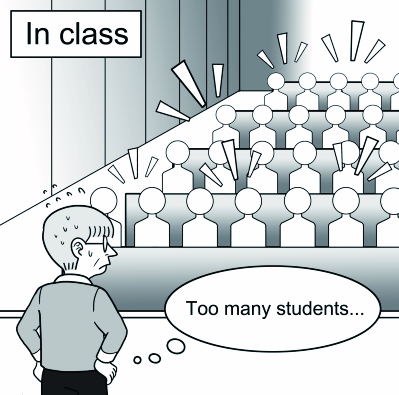
This phenomenon arose due to the announcement of the Ministry of Education (MOE) that the number of students per lecture and the ratio of large-scale lectures will be reflected on future university evaluation.
According to the survey results released on April 30 by the MOE and the Korean Council for University Education, the number of large-scale lectures decreased compared to that of the last year while the number of small or middle-scale lectures increased.
Specifically, the ratio of small-scale lectures with less than 20 students per class increased 1.2 percent from 38.1 percent of last year.
The number of middle-scale lectures with 21 to 50 students and large-scale lectures with 51 to 100 students, however, decreased by 0.6 percent and 0.5 percent respectively from 46 percent and 15.9 percent of last year.
Furthermore, noticeable improvement was shown in the number of super large-scale lectures. To be specific, the number of lectures with 101 to 200 students and lectures with more than 200 students decreased by 48 and 138, reaching 2862 and 491 this year.
“We will continue our effort to improve the quality of learning environment by maintaining the optimum size of each lecture depending on its characteristics,” said Lee Hye-jin, an officer of the University Academic Affairs and Evaluation Division in the MOE.
Students show mixed reactions toward the issue. Most of them welcome the change as the reduced number of students taking the lecture guarantees better concentration on classes.
“I was pleased to hear the news because I have experienced many discomforts in a super large-scale lecture which accommodates more than 400 students,” Park Hong-bi (Korea University, 1) said. “Not only can I barely see the screen if I sit at the back of the class, but also it is difficult to concentrate on professor’s words. Furthermore, the evaluation basis seems very ambiguous since there are too many students to evaluate.”
Universities are careful about announcing the plan for future reduction of large-scale lectures.
“It is not easy to reduce the number of super large-scale lectures because we have to consider many factors such as a lack of classes, part-time lecturers, popularity of the lecture and so on,” said Yu Il-sun, the head of Academic Affairs of Ewha Womans University. “However, the overall trend seems like the number of large-scale lectures is gradually decreasing. We will continuously monitor the situation to provide the best learning environment for students.”
Yoo Woo-jeong
wjyoo123@ewhain.net

